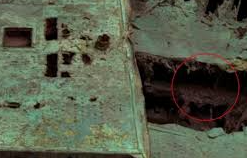Digital model reveals engineers fought to keep power running as iceberg impact punctured hull and accelerated ship’s demise
A revolutionary 3D scan of the RMS Titanic has unveiled never-before-seen details about the ship’s final hours, lending new credibility to survivor accounts and highlighting the heroic efforts of the engineering crew.
The digital recreation, described as the most accurate visual representation of the wreck to date, was produced using deep-sea submersibles that descended nearly 4,000 metres to the ocean floor. Over 700,000 high-resolution images were captured to assemble a full-scale “digital twin” of the vessel.
Among the most poignant findings is evidence that the Titanic’s engineers remained at their posts in the boiler room, likely maintaining power for as long as possible while the ship slowly succumbed to flooding. A valve observed in the open position and the visible deformation of several boilers suggest that steam systems were operational well into the disaster.
The scan also supports long-held theories regarding the iceberg strike on 14 April 1912. Despite being a glancing blow, the impact tore a line of small but deadly gashes along the hull—some no larger than an A4 sheet of paper—allowing freezing seawater to enter multiple compartments. This progressive flooding ultimately led to the ship breaking in two and plunging beneath the Atlantic in the early hours of 15 April, claiming over 1,500 lives.
A particularly compelling discovery is a shattered porthole, likely caused by the initial collision, which may confirm survivors’ descriptions of ice entering their cabins.
“Titanic is essentially the last living witness to its own fate,” said maritime historian Parks Stephenson. “The more we examine the wreck in context, the closer we come to understanding how it really happened.”
The scan forms the centrepiece of Titanic: The Digital Resurrection, an upcoming documentary from National Geographic and Atlantic Productions, aimed at piecing together the mystery of the ship’s final moments with scientific precision.
Simon Benson, a naval architecture expert from the University of Newcastle, emphasised the critical nature of the hull breaches: “Tiny perforations may not seem dramatic, but when spread over a significant length of the ship, they allow water to infiltrate slowly but inevitably. Once the bulkheads were overtopped, the vessel was doomed.”
Although hailed as “unsinkable” by its builders, the Titanic’s flawed design proved catastrophically vulnerable. Its six supposedly watertight compartments were no match for the iceberg’s reach.
The wreckage, which lies scattered across the seabed, continues to deteriorate under intense oceanic pressure and corrosion. Experts warn it may completely disintegrate within the next four decades. Items belonging to passengers still lie strewn around the site, offering a haunting glimpse into a tragedy that shocked the world.
As investigations into the wreckage grow ever more sophisticated, so too does our understanding of one of the most infamous maritime disasters in history.

